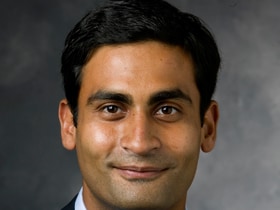
India's Slums Represent Complex Political and Social Issues
Indian slums are contrary to popular opinion incredibly productive
Slums like those depicted in the popular film "Slumdog Millionaire" are complex communities with residents of different income levels, sometimes complex relations between ethnic groups, and systems of political patronage that interest Saumitra Jha, an assistant professor of political economy at the Stanford Graduate School of Business.
The Oscar-winning film captured the vibrancy of India's slums, which are often misperceived as being simply rundown housing areas, said Jha, who studied formal and informal leadership in several slums as part of a project funded by The World Bank's Research Department. His work with the World Bank's Vijayendra Rao and Michael Woolcock surveyed 802 households from 30 slums in Delhi.
"Indian slums are incredibly productive," Jha said, adding that Mumbai, where much of "Slumdog" takes place, includes the Dharavi slum, one of the largest leather producers in the world. "People are becoming much more aware that slums are where a lot of the economic activity is taking place."
"It's not just poor people who live there," he said. Some more financially sound residents prefer living in the slums because they are inexpensive and closer to their workplaces. "It's remarkable how wide the discrepancy in wealth is." One area of Delhi that Jha describes as a "five-star slum," has running water, electricity, and other amenities. "The only reason it is a slum was because it is an illegal settlement. They just don't own the property."
Older, more established slums, where residents have formed cohesive communities such as Dariba Kalan in the medieval city of Delhi, have erupted into riots in the face of government efforts to tear them down, Jha said—even when the government has offered to resettle the displaced people.
Jha found that how the slums are run depends on a variety of factors, such as their ethnic makeup, political connections, and how long they have been established. Newer slums often have it particularly tough, he said, because they might have neither the political clout to avoid being torn down by the government nor the infrastructure to help protect residents from fire and the theft of personal items.
They also may lack the internal leadership to fend off these threats.
Key to running many slums, however, are pradhans, the areas' informal leaders, who often can call on political influence to help their neighborhoods. The study described one unnamed slum run by a former domestic servant of a mainstream political party's leader. "She basically ran the show for 20 years," Jha said. But that all changed when a rival party gained power. "Her political connections were with the wrong party."
Relying on street smarts often can do the trick. One self-preservation strategy sometimes used to protect property is for residents to build a temple, Jha said. "When police come to clear slums, they generally don't destroy temples."
Some new slums, occupied by a single major ethnic group, can gain political clout because they are more likely to follow one set of leaders, who can then promise politicians clusters of votes and turnouts of supporters at rallies. "When leadership is less clear, that can be really detrimental," he said. In slums with several ethnic or religious groups, each demographic portion of the slum might be led by its own pradhan.
Acknowledging that "Slumdog" had some "only in Hollywood (or maybe Bollywood)" moments ("They fall off the train and end up next to the Taj Mahal"), Jha said that unfortunately some grisly events, such as ethnic violence and the maiming of children so they can make more money begging, do happen.
Ethnic violence that erupts occasionally between groups might have less to do with religious fervor than with claiming a particular territory for its economic appeal, Jha said. "It seems often to be calculated."
His latest research has been to look at ethnic relationships in India, particularly the clashes that can occur between Hindus and Muslims. He cited the 2002 violence in Ahmadabad, which saw 24 days of rioting that took the lives of at least 324 people. Despite being one of India's richest areas, the region has a reputation for intense religious conflict.
But 140 miles south of there, the city of Surat, part of the same western Indian state of Gujarat, has seen virtually no religious violence even though, like Ahmadabad, it is about 13 percent Muslim.
Longtime seaports, such as Surat, had generations of complementary working relationships between Muslims and Hindus, he said. Indian Ocean trading routes were dramatically influenced by the Muslim pilgrimage, particularly the Hajj, making it less costly for Muslims to enter trade. The Muslims had such an extensive trading network that it was hard for the Hindus to compete with them, but Hindus were able to benefit from those routes by having greater access to the items being traded.
Jha said another modern example of such a complementary relationship is in Varanasi (also known as the holy city of Banaras), where Muslims are often in charge of weaving, and Hindus handle distribution.
That doesn't mean that Varanasi and Surat don't have poor areas and the ingredients for conflict, Jha said—just that they have found ways to cope successfully.
"You might think it's poverty that's driving it," Jha said about the violence elsewhere, "but that doesn't seem to be the case."
This piece originally appeared in Stanford Business Insights from Stanford Graduate School of Business. To receive business ideas and insights from Stanford GSB click here: (To sign up: https://www.gsb.stanford.edu/insights/about/emails)





